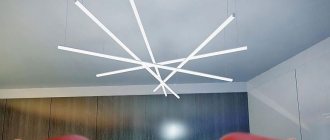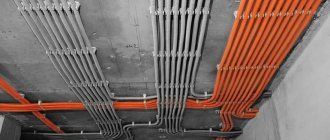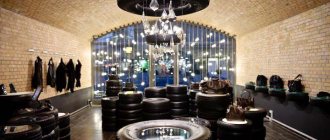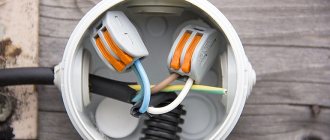In ancient times, the bathhouse was visited only during the daytime, since it was quite inconvenient to wash by the light of a candle or kerosene lamp. Nowadays, you can take water procedures at absolutely any time of the day, since modern electric lighting will ensure a comfortable pastime in the bathhouse.
Unfortunately, the bathhouse does not have favorable conditions for the operation of electrical wiring. That is why the process of installing lighting in a bathhouse deserves special attention, because neglecting it can lead to fire or electric shock to those washing.
The most important thing in this matter is compliance with safety precautions during the installation of lighting in a Russian bathhouse. In addition, do not forget that the bathhouse is designed to allow a person to relax both mentally and physically. In this regard, it is not recommended to make the lighting too bright. It should be soft, diffused and slightly muted.
Methods for connecting electrical wiring to points
In order to correctly install all the light sources in the bathhouse, you need to know how to conduct electrical wiring to each of them.
There are two ways:
- Open;
- Hidden.
It is better to install electrical wiring inside the bathhouse using an open method, since it is safer and more convenient. In this case, the wiring lines are quite easy to view, and there are no difficulties during the replacement or repair process.
It is better to conduct hidden electrical wiring to lamps only in the steam room.
You should also follow some rules when wiring to lamps:
- The electrics in the bathhouse are mounted exclusively on the lower part of the wall;
- The electric wire to the lamp in the steam room is routed directly to the place of its installation;
- It is very important that all electrical appliances in the bathhouse are grounded. This can be done using a cable consisting of three cores. Two of these conductors are connected to phase and neutral, and the third is connected to the panel or fittings;
- All sockets in the bathhouse must be provided with an individual differential switch;
- The use of artificially connected wires in the steam room is not allowed, only solid wiring;
- The wires from each of the elements are connected only on the panel;
- The shield should be installed as far as possible from the steam room.
Information. The electrical wiring cable must be laid either strictly horizontally or strictly vertically.
For baths and saunas - is there a difference?
The difference between one and the other type of national bath is the temperature and amount of moisture. In a Russian bath there is high humidity and a relatively low temperature (no higher than 70 degrees), and in a sauna the humidity is low (5-15%), but the temperature is not less than 90 degrees, and sometimes even higher than 100!
Therefore, those varieties that are more sensitive to high humidity should not be placed in a Russian bath. This primarily applies to the Himalayan salt lampshade for the bath. As mentioned above, it consists of the usual soluble salt NaCl, so moisture will ruin it.
Wood can be protected from moisture using impregnations and varnishes, which you can read about in the corresponding article.
High temperatures are contraindicated for most types of plastic, so it is strictly forbidden to use it in saunas, but moderately in Russian baths, and this does not apply to lamps, because there the heating comes from the lamps themselves.
Otherwise, there is not much difference - the same wooden models can be used as lampshades for baths and saunas.
What network voltage to choose
It is very important to determine the optimal voltage for lighting in the bathhouse - 12 (V), 36 (V) or a household voltage of 220 (V).
To use household voltage in a bathhouse, certain requirements are established:
- Protection of electrical wiring lines using RCDs or differential circuit breakers;
- Providing power to the bathhouse according to a specific system called TN-C-S;
- Potential equalization system in the bathhouse.
If it is not possible to meet the above requirements, then you should consider the option of powering the bathhouse with a 12 (V) system.
Let's start with the fact that bathhouse lighting at 12 volts is the lowest and also the most safe voltage for human life and health.
It is usually used in areas with a high degree of danger, such as a bathhouse.
The danger of placing a bathhouse in high temperatures and high humidity is explained, because such conditions have a very adverse effect on high-voltage lamps.
When exposed to high temperatures, some lamps can even explode.
Important! Under the influence of high temperatures and without proper protection of the lamps, a lighting lamp can simply explode, thereby harming the health of people in the room.
Using lighting at 12 (V) will protect the bath room, since the worst thing that can happen is a short circuit. Electric shock and the possibility of fire are excluded.
However, such universal lighting also has its drawbacks. The fact is that the use of 12-volt lighting requires a transformer, which not only complicates the circuit, but also reduces its reliability.
Attention! It is very important to find the optimal location for the transformer, since it should not be exposed to high temperatures.
Lighting elements
Now let’s look at the components of each lamp, because inside the same model you can put lamps of different types, and surround the outside with a lampshade, which will make the sauna more comfortable and stylistically uniform.
Lamps
The following types are allowed in the sauna steam room:
- incandescent lamps;
- LED;
- halogens.
ATTENTION! Please note that we are only talking about lamps, so we will not mention LED strips and fiber optics, although they can also be installed in the steam room.
Incandescent lamps
Ordinary lamps, known since time immemorial when the entire country was electrified.
The only limitation that should be taken into account concerns power - it is not recommended to use more than 60 W in the steam room, but there are no restrictions on the number of light bulbs. However, there are two unpleasant aspects associated with them:
- Firstly, they are quite fragile, break easily, and burst easily if cold (relative to their own temperature) water gets on the flask when it is heated.
- Secondly, they are connected to a 220 V network, so if there is a problem, a person can be killed by such a current. Moreover, in a bathhouse, where it is humid and water conducts electricity very well. True, there is an option: installing 36-volt ones through a transformer, many people practice it.
To protect against the first - lampshades, nets and lampshades. From the second - RCD.
LED bulbs
LEDs can be in the form of lamps and in the form of strips. Here we will consider only lamps. More complete material can be found at this link.
The sockets are different, but the E27 socket is typical for bath lighting - this is a medium threaded socket with a diameter of 27 mm, which is suitable for incandescent lamps, and for LED lamps (if they are designed for 220 V), and for halogen lamps.
BY THE WAY! LEDs are still installed in the bathhouse not so much for the sake of reducing energy consumption, but because they are powered from a low-voltage network, most often 12 V (24 and 36 V are also possible).
For LED light bulbs that are powered from a 220 V network, you can also install an RCD. And for 12-volt ones, connect either a step-down transformer (see article on electricians in a bathhouse) or a switching power supply.
IMPORTANT! The power supply should preferably have galvanic isolation, which will not allow 220 V to flow into the circuit in the event of a failure. The transformer and power supply are installed outside the steam room
The transformer and power supply are installed outside the steam room.
And now the most important thing: you can put LED lamps in a sauna, but they will not last long, because for them the temperature is already above 65 degrees on the crystal. Just imagine that the crystal itself gets very hot during operation, so heat removal is needed, which is unattainable in an overheated sauna.
So you either need to place the strips somewhere lower, as a backlight, or abandon the idea of LEDs altogether, and use regular incandescent or halogen light bulbs closer to the ceiling.
Halogen
These bulbs tolerate high temperatures well, but are not without their drawbacks. In particular, this concerns their service life. Interestingly, LEDs do not respond to the number of times they are turned on, while for halogen ones, each turn on reduces their service life.
In principle, you can find both 220 V and 12 V halogen ones on sale, but the latter have a different base from the standard E27, and in general they are not intended for insertion into conventional structures with lampshades.
How to do it in a steam room
The steam room is the smallest room in the bathhouse. Taking this into account, in most cases it is enough to place one lamp. However, in order not to be left in the dark when one lamp is faulty, it is better to install another spare one. Therefore, the optimal number of light sources in a steam room is two.
Lamps must be placed in special lighting lamps for baths. All adjacent wires must be carefully insulated.
It is recommended to place light sources in hard-to-reach places so as not to accidentally touch or damage them.
Under no circumstances should you place the lighting device next to heating elements!
Do not forget that air with a high moisture content can damage the device with damage to the wire or socket.
In this regard, it is recommended to conduct the wire in a box under a layer of vapor and waterproofing.
Let's look at it step by step - how to make light in a bathhouse in a steam room with your own hands:
- The sections of wires that will be in the steam room must be placed in a metal or corrugated pipe. Their number should be equal to the number of planned lamps;
- Next, you need to run the cables to the luminaire placement points. As mentioned earlier, the wiring in the steam room is mounted in a closed type, so you should take into account the lighting plan at the construction or renovation stage;
- It is necessary to fix the cartridges on the ends of the wires and insulate them;
- A cable is led from the distribution box to the switch, which is best placed outside the steam room;
- After this, the incandescent lamps are screwed in and placed in heat-resistant lamps;
- In order to protect yourself from burns, you should install a special wooden grill over the lamp.
Bath lampshade: shape
An interesting point: somehow it happened historically that there are two main forms - a grille and a screen. We will assume that other options, if they existed, died out due to some kind of unsuitability or inconsistency. Or the survivors turned out to be the simplest and most practical. (Of course, no one forbids doing something original; we are talking about the most common.)
Lattice
The question arises: what else could be made from slats or solid planks? The simplest and most effective way is to assemble a lattice, a kind of “fence,” leaving slits for light.
IMPORTANT! The brightness of the lighting depends on the width and number of slots.
However, even with the simplicity of the idea, variations can be sufficient - the slats can be attached to bases that will give the structure a cylindrical or conical shape, or they will be combinations of simple shapes, if you like.
BY THE WAY! The slats may not be solid - if you make a slotted pattern in them, then there will be a combination of a lattice and a screen.
The attractiveness of this form is that it harmonizes perfectly with walls finished with clapboard, or with log walls or timber. Overall, a lattice wood lampshade looks great on a wood wall. And the material for it can also be the remains of the same lining, unused during construction.
Screen
It differs from the previous version in the absence of slots between the slats. And also because some recognizable outline is usually carved into the central element. However, here, too, various variations are possible - there can be as many slotted elements as you like, not necessarily one central one.
Combinations with a lattice are possible, when a lattice is made on the sides, and in the center there is a solid strip with a cut out outline.
The slot can be left as is, without any inserts, or you can experiment - put a decorative or practical diffusing material on the back side, for example, mesh or frosted glass (we’re not talking about plastic, because it’s hot in the steam room). Without the matte material, the light may be too harsh.
ADVICE! Instead of matte material, you can use a plate with numerous small holes.
In the rest room
The relaxation room is the very place in the bathhouse where you can show your imagination in the process of arranging lighting.
There are no strict requirements for this room, so the number and type of lighting fixtures depends only on the taste of the owners.
It is best to place several light sources at different levels. The presence of overhead lighting, sconces, as well as illumination of some areas will provide the ability to choose the level of light.
You can give in to impulse and realize all your wildest fantasies regarding bath lighting. Here you can install colored lighting, lighting in the form of stars, or even create the feeling that you are in a planetarium.
Information. It is recommended to choose not too bright lighting for the rest room, since it is the very place where you can relax and unwind.
Principles of conducting electricity
Before you start making lighting in the steam room, you need to study the principle of the work. It is necessary to select lamps according to power, and correctly position them in bath rooms.
Power selection
When purchasing a lamp, you need to pay attention to the power of the device:
- optimal voltage level - 12 V;
- maximum power - 75 watts.
You cannot choose more powerful lighting fixtures, as their lampshade will overheat. Over time, this will lead to a violation of the tightness and failure of the lamp. To maintain one voltage level, you need to buy a transformer. It should be located in, closed with a metal box.
For a bath, you can choose lamps made of heat-resistant plastic, ceramics, and porcelain.
It is not recommended to buy pendant lamps.
Attention should also be paid to the presence of a seal. It should be made of heat-resistant rubber and tightly cover the junction of the lampshade with the lamp body
Selection of lighting equipment
Types of lighting fixtures:
Standard. Classic lamps in which the light bulb is covered by a shade. Can be attached to horizontal or vertical surfaces. The shape is often round or oval. Heat-resistant frosted glass is used to make lampshades. Fiber optic. Lamps made of glass fiber, which has light sources on both sides. Outwardly, they resemble a fan lamp with many threads, at the end of which light bulbs glow. Fiber optic threads can withstand heating up to 200 °C. Do not collapse when exposed to moisture or ultraviolet radiation. They produce soft, diffused light that helps you relax. The lighting device can be assembled independently from separate tubes
It is important to insulate all twists and wire connections. LED. Resistant to moisture and temperature changes
Suitable for installation underwater. This allows you to illuminate the pool. The high level of tightness of the devices is explained by the presence of a silicone sealing film. The degree of luminous flux intensity depends on the size of the LEDs. Using the remote control you can change the level of lighting.
Types of lamps by light source:
- Incandescent lamps. They have a filament inside. They only use 5% of their electricity consumption to produce light. Incandescent lamps heat up quickly. If moisture gets on hot surfaces, an explosion will occur. One of the varieties is halogen light bulbs. The technical characteristics are superior to standard products.
- LED. Harmless light sources. They have low power and shine brightly. They do not contain mercury and are energy saving. In terms of service life they are ahead of analogues. They produce a directional stream of light. To fully illuminate the room, you need to use several lamps or an LED strip of LED strip, which can be placed on the ceiling or walls.
- Luminescent. Classic energy saving lamps. These are gas-discharge tubes with a power of about 11 watts. Converts ultraviolet radiation into visible light. Mercury vapor and phosphor are pumped into the tubes. Manufacturers claim that fluorescent lamps are harmless, but during operation they release mercury vapor into the air.
Rules for choosing a lamp for a bath:
- It is prohibited to use portable lighting devices that are connected to the network in the washing room or steam room.
- It is better to choose matte products.
- It is prohibited to use lamps containing mercury in the washing steam room. Upon impact, they release toxins into the air that are harmful to health. Mercury light sources often burst due to temperature changes.
- A high-quality lamp cannot be cheap. It is recommended to find out in advance which manufacturers are the best on the world market and clarify their weaknesses.
- You need to buy an LED strip and make it into emergency lighting. The switch must be wired separately.
- When purchasing sockets, you need to choose products marked IP 54.
- If a large number of people visit the bathhouse, you need to install additional protection on the lampshades.
You need to check the lamps at the time of purchase.
How to make a fiber optic light
Each owner independently chooses the type of lighting for his bathhouse, but experts recommend choosing fiber optic lighting.
Lamps of this type can be used even without a wooden lampshade, as they do not dazzle the eyes and can also withstand temperatures up to 200 degrees.
Fiber optic lighting has proven itself to be the safest and most durable. It is very easy to install and also decorate for an exclusive interior.
Making a lamp for a bathhouse with your own hands is simple and inexpensive; for this you need to purchase:
- Wood;
- Glass with a minimum thickness of 4 mm;
- Plywood;
- Heat-resistant film;
- Aluminum tape;
- Glue.
First of all, templates of the main parts are cut out of plywood, and vertical strips, the edges of which are rounded, are cut out of wood. Next, the main parts are fastened to the strips and coated with glue. The fastening points are tightened with self-tapping screws.
The glass is cut out and wrapped with heat-resistant film.
After this, the planks are sawn, coated with glue and tightened with self-tapping screws.
You need to mark points on a couple of strips, then drill holes for the glass. Secure the glass also using strips.
Drill holes with a diameter of 5 mm in the getinax sheet.
On the back side of the panel you need to glue the LEDs using superglue. Aluminum tape serves as a reflector.
Next, a power supply is installed outside the steam room, from which a cable is routed to the lamp through the wall.
The lamp is attached to the walls of the bathhouse using self-tapping screws.
What should you pay attention to when choosing lamps for your bath?
In the case of traditional Russian baths, you should not install lighting in the ceiling. There are certain conditions under which lighting points are installed at least 30 cm from the sauna ceiling. Also, due to the nature of the fixtures, choosing LED bulbs is not the best choice for sauna lighting. Light-emitting diodes remain sensitive to very high temperatures as well as strong temperature fluctuations. Sauna conditions will significantly reduce the lifespan of the LED. This does not mean, however, that lamps of this type are not used at all. LED lights are placed in the lower parts of the sauna cabins in the form of luminous grids in the floor section or as LED strips located below the seat line.
Choose one of the many lighting options for your sauna, which guarantees safe installation and long service life in the steam room, providing its users with maximum comfort.
Wooden lamps
Very often, wooden grilles are used to decorate and protect the lamp.
They not only look very beautiful and harmonious in a wooden structure, but also protect careless bathhouse visitors from burns.
These lampshades look quite attractive. The light emanating from a lamp with a wooden grille is very soft and diffused.
Making a bathhouse lamp with your own hands from wood is very simple! The simplest wooden structure consists of an upper and lower base, as well as slats.
The shape of the frame is determined depending on the location where the lamp is planned to be placed. If the lamp is wall-mounted, then the frame is rectangular or round. If it is angular, then the part should be close to a triangular shape.
The planks are attached to the frame from the inside to avoid burns from the surface of the screws in the future.
Do-it-yourself electric lighting installation
To ensure that arranging lighting in the steam room does not turn out to be an impossible task for you, we suggest you study the step-by-step instructions.
Preparation
- Stages of preparatory work:
- Make a diagram. Indicate all wiring lines, as well as the locations of sockets, switches, the presence of a boiler, heated floors and a transformer. Grounding is taken into account. An automatic machine and an RCD are installed on each branch;
- Calculate the amount of necessary materials and components. Determine which cable and how much will be needed. In this case, the power of the lighting equipment is taken into account. Don't forget about distribution boxes and cable ducts;
- They buy everything they need. It is better to purchase wires and elements measured by footage in excess. It is not recommended to save on purchases - you should choose quality products.
Device: features
The most important room in any bathhouse, be it a Russian steam room or a Finnish sauna, is the steam room. The quality of the procedures performed in the steam room will depend on it. Despite the fact that it is very important, it is not so difficult to build, because it consists of a small number of elements. The most important thing is that the arrangement of the room is comfortable and suitable for proper rest.
First of all, it is worth determining the number of shelves and racks, taking into account how many people plan to visit the bathhouse. They must be made of a material that, when exposed to high temperatures, does not fill the air with resins. The best option would be aspen, which has a low price and many positive characteristics.
It is also necessary to install a stove in the bathhouse, which is the most important element in the steam room. After all, it provides the desired temperature in the building, fully warming it up. Currently, any stove can be installed in the steam room. It can be made of brick, stone, metal, even electric models are used.
Don't forget about the washing machine. It can be combined with a steam room, and the veranda can be used as a dressing room. However, this option is not very convenient. After all, then you will have to suspend the process of using steam while taking water procedures. To prevent this from happening, you can install a shower stall.
Varieties
In stores you can see different lighting devices that are suitable for a bathhouse. Products come in several types.
Waterproof
For a bathhouse, it is better to choose lamps with LED or energy-saving bulbs. Devices must have additional moisture protection. When purchasing a lamp, you need to check the presence of a sealing gasket.
Heat resistant
To make the lighting inside the steam room safe for visitors, you need to choose heat-resistant structures. The housing is made of materials resistant to high temperatures
It is important that the device parts can withstand heating up to 120 °C
You should not order cheap bath lamps from China. More often they become unusable after the first warming up of the steam room. Under the influence of high temperatures, a housing made of low-quality plastic can melt, ruin the decorative finish, and get hot drops onto visitors.
Halogen
For a bath, you can use lamps with a gas mixture - halogen. The gas is contained in a sealed glass flask. Advantages of halogen lamps:
- High tightness of the housing. No moisture or dust particles get inside the device.
- Low power. The average value is from 20 to 30 watts.
- Halogen lamps create natural light that is easy on the eyes.
- Heat resistance. Since the lamp heats up to 400 °C, it does not become unusable when exposed to high temperatures.
LED
Lighting in a steam bath with LEDs (individuals or strips) is a popular option for the interior design of showers, dressing rooms and steam rooms. On sale you can find LED strips of different colors, with the possibility of remote control and additional functions.
LED strips are suitable for decorating canopies, baseboards, benches, and niches. If you don’t want to use tape, you can buy a lamp. Advantages:
- many color effects;
- durability, reliability;
- environmental friendliness;
- resistance to moisture;
- economical energy consumption;
- easy installation.
The lamps have no serious shortcomings. The devices can only be installed in the shower and dressing room. The devices do not tolerate strong heat, but if it is not possible to use other types of lamps, and the LED strip remains, you can fix it at the level of the shelves inside the steam room.
Fiber optic
Made from synthetic or glass fibers. The light inside is generated by the operation of the projector. Advantages of fiber optic tubes:
- resistance to temperature changes and prolonged exposure to moisture;
- obtaining a diffused stream of light that does not strain the eyes;
- energy saving;
- Possibility of use for different rooms;
- long service life during active use.
Using fiber optic lamps, you can lay out a starry sky on the ceiling. To do this, a niche is created in advance with holes in which luminous tubes are fixed.
What types should not be used?
Incandescent lamps must not be used in the bathhouse. The surfaces of the light bulb become very hot and if moisture gets on the glass surface, an explosion may occur. The lamp itself is easy to break if hit.
Conclusion
As you can see, installing a bathhouse lighting network is not very difficult. But here it is important to pay attention to all aspects and norms. After all, the cost of ignoring these rules can be very high. Otherwise, if you have basic knowledge of electrical engineering, you can easily complete the installation yourself.
Sources
- https://Web-electric.ru/osveschenie-v-bane
- https://220.guru/osveshhenie/istochniki-sveta/svetodiodnaya-lenta-dlya-sauny.html
- https://vamfaza.ru/svetilniki-i-lampy-dlja-sauny/
- https://stroy-podskazka.ru/svetilniki/dlya-bani/
- https://dekoriko.ru/banya/svetilniki-v-parilku/
- https://StrojDvor.ru/elektrosnabzhenie/kak-pravilno-sdelat-osveshhenie-v-parnoj-bani-svoimi-rukami/
- https://stroy-podskazka.ru/svetilniki/dlya-bani-v-parilku/
- https://probani.guru/kommunikacii/kak-provesti-svet-v-parilku/
- https://parilochka.com/provodka-v-bane/osveshhenie
- https://okcomfort.com/elektrika/osveshenie/v-bane-svoimi-rukami.html
- https://v-banyu.ru/osveshhenie-v-parilke-bani.html
- https://LampaExpert.ru/svetilniki/dla-bani
- https://Elektrik-a.su/osveshhenie/vnutrennee/dlya-bani-osveshhenie-355
Types of electrical wiring: advantages and disadvantages
- Electrical wiring is:
- open;
- hidden.
- Open wiring is usually installed in steel boxes, corrugated hoses, or in special trays and electrical baseboards. Electrical wires are usually laid along the walls, on the ceiling and placed on supports. Open wiring has a number of advantages: firstly, it is cheaper, because there is no need to perform additional gating of the walls, and secondly, such wiring is much easier to repair.
- The disadvantages of open wiring include:
- her unpresentable appearance;
- the fact that plastic boxes in wooden walls deform over time;
- The corrugated pipe quickly collects dust, and when laying it it is quite difficult to maintain a perfect vertical or horizontal position.
Hidden electrical wiring is contained in special boxes, which must be recessed in walls, ceilings, ceilings and located below floor level. Particular attention must be paid to insulating cable joints. If hidden wiring is laid from the inside of a wooden structure, then the wires must be laid with insulation on top and bottom of the electrical wires. For steam rooms and saunas, it is recommended to install hidden wiring, which should have the following advantages:
- high degree of fire safety;
- moisture resistance;
- do not have direct contact with hot air in the bath;
- be much more durable;
- do not spoil the design and appearance of the room.
- Hidden wiring during installation has a number of shortcomings and inconveniences, namely:
- difficulty of access to repair damage;
- labor costs during installation.
Materials
Not all materials are suitable for the production of lampshades and lamp shades due to the specific external influences to which the products are exposed. More suitable are:
- glass. For wall-mounted lampshades, thick milky or matte glass is used. Provided the product is completely sealed, you can use an incandescent lamp. Glass lamps differ in the color and shape of the shades; the top can be covered with a metal grill. There are also exclusive options, for example, a lamp made in the shape of a kerosene lamp. The combination of glass and dark antique metal looks very impressive. Since the product is quite voluminous, it is recommended to use it in spacious baths;
- Heat-resistant types of plastic and plastics, aluminum and stainless steel are also used in the production of lighting fixtures for bathhouses. The main requirement is heat resistance and environmental friendliness;
Staying in such a microclimate is very useful for bronchial pathology, skin and nervous system diseases.
The ionization intensity remains at the same level even after a long period of time. When heated, the molecules of the substance release vapors containing many useful microelements. This property explains the healing effect, which is similar in healing power to the healing effect of salt caves, which have been so popular lately.
Himalayan salt slabs and lampshades differ from each other in shades. You can choose more saturated colors with slightly less transparency, or you can choose products in soft pink shades that transmit light well and simulate mesmerizing lighting, thanks to the beautiful pattern of the material structure.
Lampshades and screens made from Himalayan salt do not require special care. It is enough to carry out wet processing, removing dust and dirt. Salt lamps can be used in any room of a bathhouse or sauna, but from the point of view of health improvement, they will be most useful in a steam room. The products are produced in a wide price range, the cost depends on the size of the model and the complexity of the design, which allows you to purchase a budget version of the lamp.
Wood fits harmoniously into the bath interior, continuing the image and being the final touch of the design. Natural and environmentally friendly material is ideal for the manufacture of wooden screens and grilles. In the factory production of wooden lampshades, abasha, linden and cedar wood is used. These breeds perfectly tolerate the high humidity of a Russian bath and the dry heat of a Finnish sauna, without losing their beautiful appearance, without swelling or drying out.
The cheapest material is linden. It smells nice and withstands temperature changes well. Abash and cedar are expensive species with a beautiful wood structure, durable, moisture-resistant and durable. You can’t get burned on them, which is very convenient in steam rooms and washing rooms.
Lampshades that are made from several wood species with different structures look impressive. For independent production of gratings and screens, it is better to use bast, wicker and birch bark. These are inexpensive species, they cut and polish well, are moisture resistant and are not afraid of high temperatures. Coniferous wood, namely pine and spruce, should not be used in the production of lampshades due to high resin release in hot steam rooms. You can burn your hands on such a product.
Wooden lampshades are made in the form of a lattice or screen with one or more diffuse holes through which the light flux passes. Lamps can be attached to the load-bearing surface in a corner or wall manner. Corner is suitable for small rooms, allowing you to save space and evenly illuminate the space.
The decorative grille is in perfect harmony with the wooden interior of all rooms of the bathhouse and can be made of slats or round rods fixed in the grooves of the frame. This type of lampshade looks great with decorative barrels, buckets and tubs, as well as with foot grates.
Safety regulations
Lamps for saunas and baths will illuminate a room where the temperature reaches 100-120°C. Therefore, they must have sufficient heat resistance.
High humidity is another source of potential danger when operating lighting fixtures. Therefore, a lamp for a steam room in a bathhouse or washroom must be waterproof. Additional protection will be provided by sealed lampshades that are resistant to moisture and high temperatures.
It is necessary to choose sealed lampshades for the bath
It is better to install lighting sources under the ceiling or in the corners of the room
In this case, it will be possible to avoid accidental contacts and/or mechanical damage to lighting devices due to negligence. When choosing lampshades, the main condition is tightness. To give additional aesthetic properties to a simple lamp, you can use openwork wooden overlays in the form of gratings or carved screens
It is better to install lighting in the corners of the room under the ceiling. Wooden grilles are often used to refract lighting in the bathhouse and as lampshades
Sources of light
Based on the type of light source, lamps are divided into several categories. Let's look at the main ones to understand their relevance in the steam room. Ignorance of these nuances can cause a dangerous situation.
Incandescent lamps
These light sources are classic Ilyich bulbs. They have an incandescent filament and produce a predominantly warm light. The advantage is the price, but they have more disadvantages. They convert the bulk of the electricity consumed into heat - a small part is used for light (no more than 5% of total consumption). At the same time, the lamps become so hot even without high temperature that touching them can cause a burn. They are uneconomical, add heat to the lampshade, and are dangerous for the steam room. These also include halogen lamps, whose properties are slightly better.
Luminescent
These models are nothing more than the usual energy-saving light bulbs, which are expensive and advertised as harmless. They are an 11-watt luminous gas-discharge tube that converts UV radiation into visible light using a phosphor and a discharge of mercury vapor. They are electroluminescent, cold cathode and hot start, and flicker and buzz during operation. Their service life is longer than incandescent lamps; compared to them, these varieties emit less carbon dioxide into the air and are not resistant to power surges. During operation, mercury vapor is released into the room.
LED
These light sources are rightfully recognized as harmless. Their price is not much different from fluorescent ones. At minimum power they shine quite brightly, in fact they are energy saving and do not contain mercury. The service life of such light sources is longer than any other analogues.
Their glow is directional, so it will not be possible to illuminate the entire space without shadow corners with one such lamp. However, if you use a perimeter strip light with two rows of diodes, you can achieve even lighting in the steam room. Due to its elasticity, the tape can be laid around the perimeter without the need for cutting. It is easy to mount, which allows for angular lighting options.











